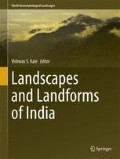Abstract
The Himalaya of northern India comprise a series of mountain ranges, including the Siwaliks, Lesser and Greater Himalaya and Transhimalaya. The region is amongst the most geomorphically dynamic on the planet. The mountain ranges that constitute the Himalaya are the consequence of the continued collision of the Indian and Eurasian continental lithospheric plates. In addition to the tectonic processes that help create the mountains, glaciers and their associated processes, vast rivers that drain the mountains, mass movements, aeolian processes and weathering, are actively shaping them. Human-influences are also becoming important in modifying Himalayan landscapes, but their magnitude is yet to be fully assessed. The relative importance of tectonic and surface processes varies across the Himalaya, and their magnitude and frequency is greatly influenced by the climate gradients and topography. The spatial and temporal variation in processes has led to a great diversity in landscapes throughout the Himalaya of northern India, making it one of the most fascinating and challenging places to study geomorphology and landscape evolution.
Access this chapter
Tax calculation will be finalised at checkout
Purchases are for personal use only
References
Adams B, Dietsch C, Owen LA, Caffee M, Spotila J, Haneberg B (2009) Exhumation and incision history of the Lahul Himalaya, northern India, based on (U-Th)/He thermochronometry and terrestrial cosmogenic nuclide dating techniques. Geomorphology 107:285–299
Ali SN, Biswas RH, Shukla AD, Juyal N (2013) Chronology and climatic implications of late Quaternary glaciations in the Goriganga valley, Central Himalaya, India. Quatern Sci Rev 73:59–76
Barnard PL, Owen LA, Sharma MC, Finkel RC (2001) Natural and human-induced landsliding in the Garhwal Himalaya of Northern India. Geomorphology 40:21–35
Barnard PL, Owen LA, Sharma MC, Finkel RC (2004) Late Quaternary (Holocene) landscape evolution of a monsoon-influenced high Himalayan valley, Gori Ganga, Nanda Devi, NE Garhwal. Geomorphology 61:91–110
Benn DI, Owen LA (2002) Himalayan glacial sedimentary environments: a framework for reconstructing and dating former glacial extents in high mountain regions. Quatern Int 97–98:3–26
Brown ET, Bendick R, Bourles DL, Gaur V, Molnar P, Raisbeck GM, and Yiou F (2002) Slip rates of the Karakoram fault, Ladakh, India, determined using cosmic ray exposure dating of debris flows and moraines. J Geophys Res 107(B9, 2192):7-1–7-8
Coxon P, Owen LA, Mitchell WA (1996) A late Quaternary catastrophic flood in the Lahul Himalayas. J Quat Sci 11:495–510
Dortch JM, Owen LA, Haneberg WC, Caffee MW, Dietsch C, Kamp U (2009) Nature and timing of mega-landslides in northern India. Quatern Sci Rev 28:1037–1056
Dortch JM, Owen LA, Schoenbohm LM, Caffee MW (2011a) Asymmetrical erosion and morphological development of the Ladakh Range, Northern India. Geomorphology 135:167–180
Dortch JM, Owen LA, Caffee MW, Kamp U (2011b) Catastrophic partial drainage of Pangong Tso, Northern India and Tibet. Geomorphology 125:109–121
Dortch JM, Owen LA, Caffee MW (2013) Timing and climatic drivers for glaciation across semi-arid western Himalayan-Tibetan orogen. Q Sci Rev 78:188–208
Drew F (1873) Alluvial and lacustrine deposits and glacial records of the upper Indus basin; Part 1, Alluvial deposits. Geol Soc London Q J 29:449–471
Goswami CC, Mukhopadhyay D, Poddar BC (2013) Geomorphology in relation to tectonics: a case study from the eastern Himalayan foothills of West Bengal, India. Quatern Int 298:80–92
Hodges K (2006) Climate and the evolution of mountains. Sci Am August:72–79
Ives JD, Messerli B (1989) The Himalayan dilemma: reconciling development and conservation. Routledge, London 324 p
Kumar S, Wesnousky SG, Rockwell TK, Briggs RW, Thakur VC, Jayangondaperumal R (2006) Paleoseismic evidence of great surface-rupture earthquakes along the Indian Himalaya. J Geophys Res 111:B003309
Larsen I, Montgomery DR (2012) Landslide erosion coupled to tectonics and river incision. Nat Geosci 5:468–473
Lee SY, Seong YB, Owen LA, Murari MK, Lim HS, Yoon HI, You K-C (2014) Late Quaternary glaciation in the Nun-Kun massif, Northwestern India. Boreas 43: 67–89
Molnar P, England P (1990) Late Cenozoic uplift of mountain ranges and global climate change: Chicken or egg? Nature 346:29–34
Murari MK, Owen LA, Dortch JM, Caffee MW, Dietsch C, Fuchs M, Haneberg WC, Sharma MC, Townsend-Small A (2014) Timing and climate drivers for glaciation across monsoon-influenced regions of the Himalayan-Tibetan orogan. Quatern Sci Rev 88:159–182
Owen LA (1996) Quaternary lacustrine deposits in a high-energy semi-arid mountain environment, Karakoram Mountains, Northern Pakistan. J Quat Sci 11:461–483
Owen LA (2011) Quaternary glaciation of Northern India. In: Elhers J, Gibbard P, Hughes PD (eds) Quaternary glaciations: extent and chronology: a closer look. Developments in Quaternary science, vol 15, 2nd edn. Elsevier, Amsterdam, pp 929–942
Owen LA, Dortch JM (2014) Quaternary glaciation of the HImalayan Tibetan orogen. Quatern Sci Rev 88:14–54
Owen LA, England J (1998) Observations on rock glaciers in the Himalayas and Karakoram Mountains of northern Pakistan and India. Geomorphology 26:199–213
Owen LA, Sharma MC (1998) Rates and magnitudes of paraglacial fan formation in the Garhwal Himalaya: implications for landscape evolution. Geomorphology 26:171–184
Owen LA, Sharma M, Bigwood R (1996) Landscape modification and geomorphological consequences of the 20 October 1991 earthquake and the July–August 1992 monsoon in the Garhwal Himalaya. Z Geomorphologie 103:359–372
Searle MP (1991) Geology and tectonics of the Karakoram mountains. Wiley, Chichester
Whipple K, Kirby E, Brocklehurst S (1999) Geomorphic limits to climatically induced increases in topographic relief. Nature 401:39–43
Yin A, Harrison TM (2000) Geologic evolution of the Himalayan-Tibetan orogen. Ann Rev Earth Planet Sci 28:211–280
Author information
Authors and Affiliations
Corresponding author
Editor information
Editors and Affiliations
Rights and permissions
Copyright information
© 2014 Springer Science+Business Media Dordrecht
About this chapter
Cite this chapter
Owen, L.A. (2014). Himalayan Landscapes of India. In: Kale, V. (eds) Landscapes and Landforms of India. World Geomorphological Landscapes. Springer, Dordrecht. https://doi.org/10.1007/978-94-017-8029-2_4
Download citation
DOI: https://doi.org/10.1007/978-94-017-8029-2_4
Published:
Publisher Name: Springer, Dordrecht
Print ISBN: 978-94-017-8028-5
Online ISBN: 978-94-017-8029-2
eBook Packages: Earth and Environmental ScienceEarth and Environmental Science (R0)

